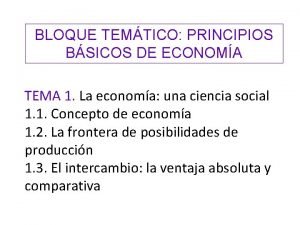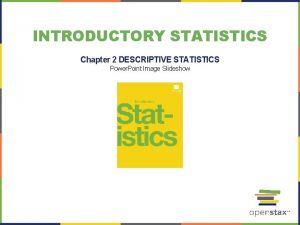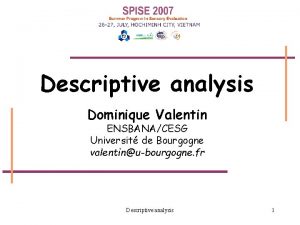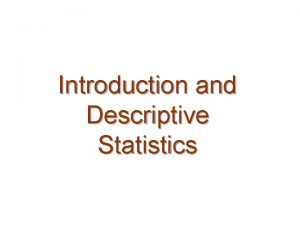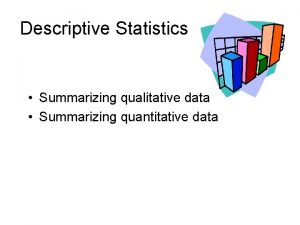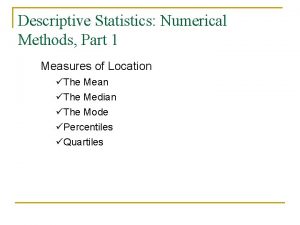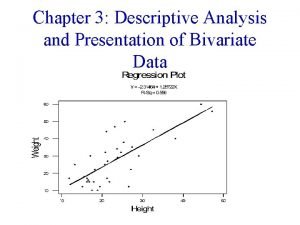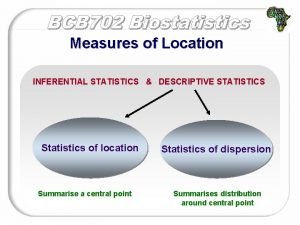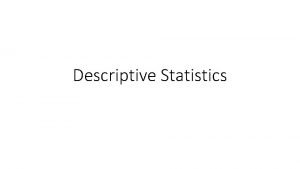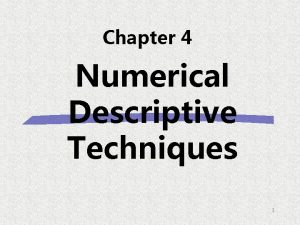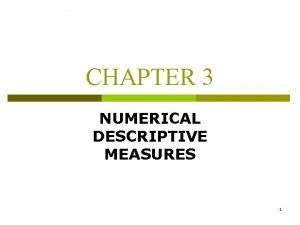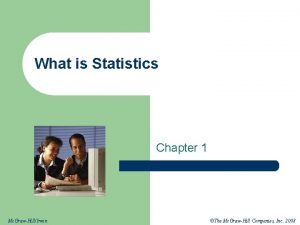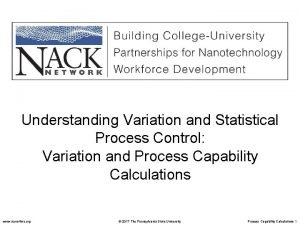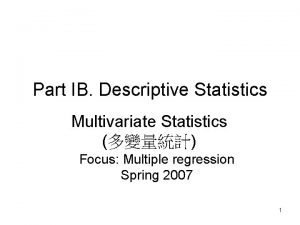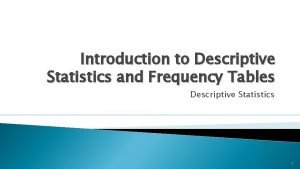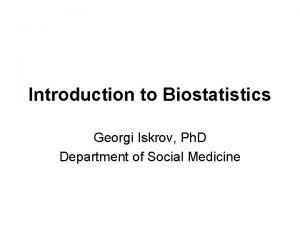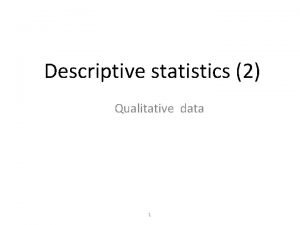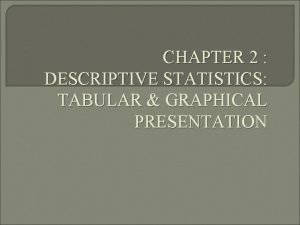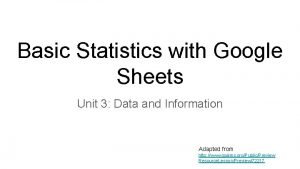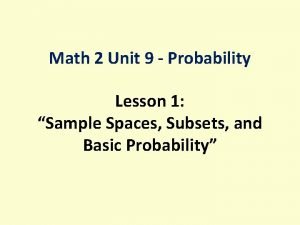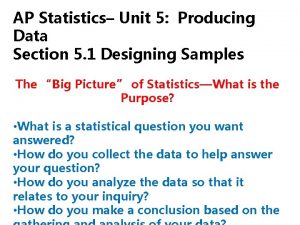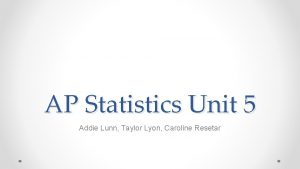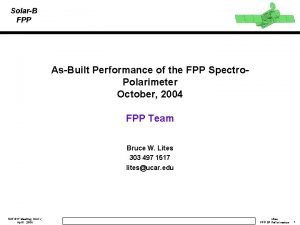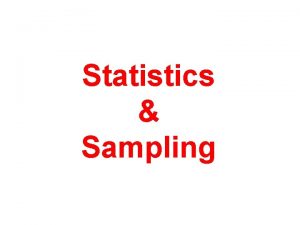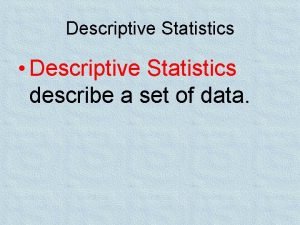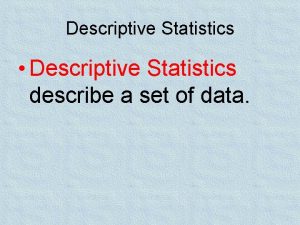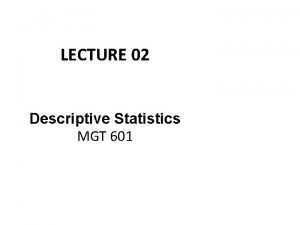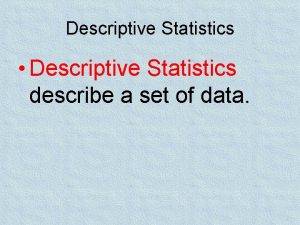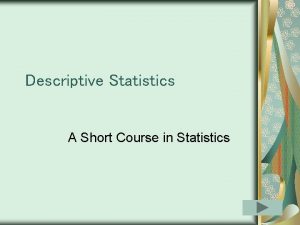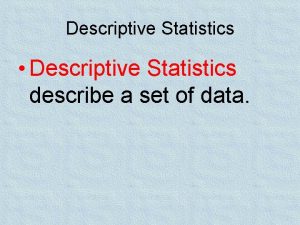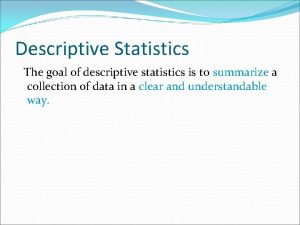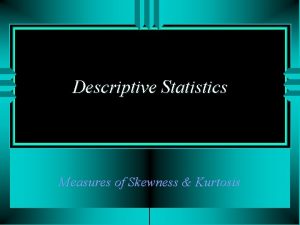Unit 3 Summary Statistics Descriptive Statistics FPP Chapter
































- Slides: 32

Unit 3 Summary Statistics (Descriptive Statistics) FPP Chapter 4 For one variable - Center of distribution "central value", "typical value" - Spread of distribution How variable are the values in a set of data? - Measure how many / what proportion of observations are above / below a given value. 3 -1 Stats W. 01

Summary Statistics Purposes: compact reporting easy comparison Important considerations: interpretable stable We will discuss: • how the statistics are defined • when each is (in)appropriate • how to interpret them • how to compute them • "guesstimation" techniques 3 -2 Stats

Example: Hospital Charges Total charge (in dollars) of the hospital stay for 29 normal deliveries of babies Charges 1, 905 2, 324 2, 048 2, 888 2, 907 2, 840 2, 607 2, 823 2, 310 2, 953 2, 138 3, 418 4, 903 3, 729 3, 709 5, 063 3, 932 3, 392 3, 287 3, 819 4, 248 2, 640 2, 921 2, 785 2, 804 2, 955 2, 219 2, 184 2, 681 3 -3 Stats 14, 898

Definitions 12 10 8 freq. 6 4 2 1500 2500 3500 4500 5500 Hospital Charges (in Dollars) mode = most frequently occurring value = ________ median = "middle value" = _________ = mean = sum / # measurements in the data set = = _____/______ = _____ another way to compute the mean: 3 -4 Stats =

Locating These Summary Statistics on a Histogram 12 10 8 freq. 6 4 2 1500 2500 3500 4500 5500 Hospital Charges (in Dollars) mode: median: mean: comparing mean & median: For skewed histograms, the mean could be deceiving. 3 -5 Stats

3 -6 Stats

Event Day Abnormal Returns (ref. "Marketing Science", Fall 1987, vol 6, no 4, pages 320335, "Does It Pay to Change Your Company's Name? ") -1. 84 -0. 31 0. 02 0. 53 1. 09 0. 30 -1. 38 -0. 24 0. 06 0. 55 1. 12 0. 34 -1. 00 0. 58 -0. 59 0. 78 -0. 57 0. 81 -0. 56 0. 96 -0. 51 0. 98 -0. 44 0. 09 0. 36 0. 10 0. 39 0. 13 0. 40 0. 21 0. 41 0. 23 0. 43 3 -7 Stats 0. 24 0. 45 -0. 24 -0. 20 -0. 16 -0. 05 -0. 02 1. 23 1. 43 1. 50 1. 64

mode = most frequently occurring value =______ median = "middle value" = _____ mean = "average" = (sum of values in list)/(# values in list) = _____ / _____ = _____ p th percentile = the value with p percent of the list less than (or equal to it) and 100 -p percent greater than it 10 th percentile = _____ 25 th percentile = _____ 80 th percentile = _____ 3 -8 Stats

Histogram for Abnormal Returns 0. 4 20 0. 3 15 0. 2 10 0. 1 5 -2. 0 -0. 5 1. 0 2. 5 4. 0 RETURNS 3 -9 Stats

Does This Statistic Make Sense? Some summary statistics make sense only for certain types of data. mean: median: mode: 3 -10 Stats

Water Watch 3 -11 Stats

Aug 1 -22 the average consumption was 223. 7 million gallons per day. Aug 1 -25 the average consumption was 224. 4 million gallons per day. Q 1: Was the average consumption higher Aug 1 -22 or Aug 23 -25? Q 2: What was the total amount of water consumed Aug 23 -25? Q 3: What was the average daily consumption Aug 23 -25? 3 -12 Stats

Baseball Batting Averages Suppose batting average = (# hits / # at bats) x 1000 Before the game starts, a player has batting average = 250. - first at bat, strikes out - new batting average = 200 Q 1: How many times has this batter been up? Another player starts the game with batting average 500. After his first at bat, his new batting average is 524. Q 2: Did he get a hit? Q 3: How many times has this batter been up? 3 -13 Stats

3 -14 Stats

Measures of Location & Spread of a Data Set LOCATION mean median mode SPREAD standard deviation (SD) range variance 3 -15 Stats

Range RANGE: (largest measurement) - (smallest measurement) example: 3 -16 Stats

Deviation from Average definition: deviation from average = data value - average note: A deviation can be zero. 1 2 5 7 10 data value 3 -17 Stats

Standard Deviation of a list of numbers definition: standard deviation = SD = rms size of the deviations from average = 3 -18 Stats

rms (root mean square) size of a list of numbers root-mean-square (rms) operation 1 2 5 7 10 data value deviation 3 -19 Stats

Standard Deviation Try another list of numbers. Find the standard deviation (rms size of the deviations from average) for this list of numbers. 2, - 6, 12, 4, 6 I. Find the average of this list of numbers. II. Find the deviation of each value from this average. III. Find the rms size of the list of deviations. -6 -5 -4 -3 -2 -1 0 1 2 3 4 5 6 7 8 9 10 11 12 data 3 -20 Stats

Standard Deviation The STANDARD DEVIATION (SD) OF A DATA SET measures how far away numbers are from their average. Most entries on the list will be somewhere around one SD away from the average. Very few will be more than two or three SDs away. 3 -21 Stats

Interpreting the Standard Deviation * Roughly 68% of the entries on a list (roughly 2/3 of the entries) are within one SD of the average. * The other 32% (approximately 1/3) are further away. ** Roughly 95% (19 out of 20) are within two SDs of the average. ** The other 5% are further away. The 2/3 rule is true for most data sets. The 95% rule is true for many data sets, but not all. 3 -22 Stats

Delivery Times Example TIME IN DAYS 27 68 79 71 80 91 43 71 81 71 83 94 47 73 84 94 50 74 84 75 86 97 58 76 88 77 88 106 91 108 93 116 94 120 97 123 103 128 10743 10844 12049 12254 12765 Class Limits Tallies Frequency 25 -34 | 1 35 -44 ||| 3 45 -54 |||| 4 55 -64 | 1 65 -74 |||| 8 75 -84 |||| 10 85 -94 |||| 9 95 -104 ||| 3 105 -114 |||| 4 115 -124 |||| 5 125 -134 || 3 -23 Stats

Delivery Times Continued Days Elapsed Between Order Date and Delivery Date for 50 Orders . 20 rel. freq. . 16. 12. 08. 04 25 45 65 85 105 125 Elapsed Time to Delivery average (mean) = median = SD = days 3 -24 Stats

Delivery Times - 3 “The 2/3 Rule” says that Roughly 2/3 or 68% of the entries on a list are within one SD of the average. 108. 0 days Actually, in this data set, 34 out of 50 deliveries took between 59. 4 and 108. 0 days. 34/50 = 0. 68 = 68% “The 95% Rule” says that Roughly 95% of the entries on a list are within two SD’s of the average. 108. 0 days Actually, 49 out of 50 deliveries took between 35. 1 and 132. 3 days. 49/50 = 0. 98 = 98% 3 -25 Stats

3 -26 Stats

Guesstimating the SD Middle 2/3 Rule 1. Locate the middle 2/3 of the data. 2. The range of the middle 2/3 of the data is approximately 2 SD's. So, 1/2 of this range is approximately 1 SD. 3 -27 Stats

Variance The variance of a list of numbers is the SD squared. That is, the SD is the square root of the variance. 3 -28 Stats

z-score The z-score says how many SD's above (+) or below (-) the average a value is. The sample z-score for a measurement is z= The population z-score for a measurement is z= example: 3 -29 Stats

Interpreting z-scores Interpretation of z-Scores for "Mound-Shaped" Distributions of Data 1. Approximately 68% of the measurements will have a z-score between -1 and +1. 2. Approximately 95% of the measurements will have a z-score between -2 and +2. 3. All or almost all of the measurements will have a z-score between -3 and +3. 3 -30 Stats

Wonderlic Scores 3 -31 Stats

USC had average team score 20. 3. What is their zscore? Is this value extreme among NCAA Division I teams? How about Michigan State whose average team score is 16. 6? Find their z-score and interpret it. How about Stanford whose average team score is 28. 2? Find their z-score and interpret it. . 3 -32 Stats
 Fpp test
Fpp test Fpp
Fpp Fsm and fpp
Fsm and fpp Chapter 2 descriptive statistics answer key
Chapter 2 descriptive statistics answer key What is the value of σx2 for the scores 1, 0, 2, 4?
What is the value of σx2 for the scores 1, 0, 2, 4? Hypothesis setting
Hypothesis setting Example of descriptive statistics
Example of descriptive statistics Descriptive statistics ap psychology
Descriptive statistics ap psychology Introduction to descriptive statistics
Introduction to descriptive statistics Descriptive statistics for qualitative data
Descriptive statistics for qualitative data Numerical descriptive statistics
Numerical descriptive statistics Numerical methods of descriptive statistics
Numerical methods of descriptive statistics Bivariate descriptive statistics
Bivariate descriptive statistics Measures of location statistics
Measures of location statistics Types of descriptive statistics
Types of descriptive statistics Jack in box
Jack in box Variance standard deviation formula
Variance standard deviation formula Inferential statistics definition
Inferential statistics definition Data pensylvania1
Data pensylvania1 Descriptive statistics definition
Descriptive statistics definition Multivariate descriptive statistics
Multivariate descriptive statistics Categorical frequency distribution example
Categorical frequency distribution example Descriptive statistics
Descriptive statistics Descriptive statistics classification
Descriptive statistics classification Tabular presentation of qualitative data
Tabular presentation of qualitative data Descriptive statistics in google sheets
Descriptive statistics in google sheets How to lie with statistics summary
How to lie with statistics summary Unit 10, unit 10 review tests, unit 10 general test
Unit 10, unit 10 review tests, unit 10 general test Introduction to statistics what is statistics
Introduction to statistics what is statistics Unit 9 probability and statistics answer key
Unit 9 probability and statistics answer key Ap statistics unit 5
Ap statistics unit 5 Chapter 7 ap stats review
Chapter 7 ap stats review Ap statistics unit 5
Ap statistics unit 5

